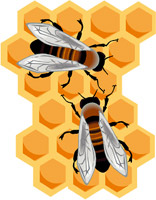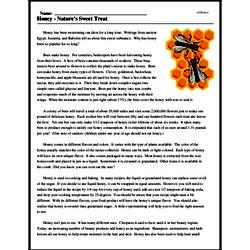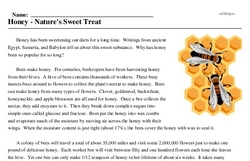Honey - Nature's Sweet Treat
National Honey Month
Reading Comprehension for September 2
Honey has been sweetening our diets for a long time. Writings from ancient Egypt, Sumeria, and Babylon tell us about this sweet substance. Why has honey been so popular for so long?
Bees make honey. For centuries, beekeepers have been harvesting honey from their hives. A hive of bees contains thousands of workers. These busy insects buzz around to flowers to collect the plant's nectar to make honey. Bees can make honey from many types of flowers. Clover, goldenrod, buckwheat, honeysuckle, and apple blossoms are all used for honey. Once a bee collects the nectar, they add enzymes to it. Then they break down complex sugars into simple ones called glucose and fructose. Bees put the honey into wax combs and evaporate much of the moisture by moving air across the honey with their wings. When the moisture content is just right (about 17%), the bees cover the honey with wax to seal it.
A colony of bees will travel a total of about 55,000 miles and visit some 2,000,000 flowers just to make one pound of delicious honey. Each worker bee will visit between fifty and one hundred flowers each time she leaves the hive. Yet one bee can only make 1/12 teaspoon of honey in her lifetime of about six weeks. It takes many bees to produce enough to satisfy our honey consumption. It is estimated that each of us uses around 1.31 pounds per year! (One note of caution: children under one year of age should not eat honey.)




